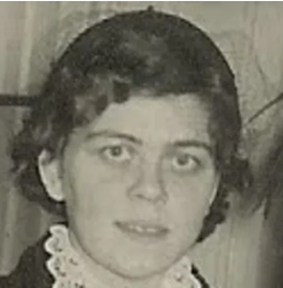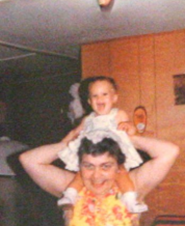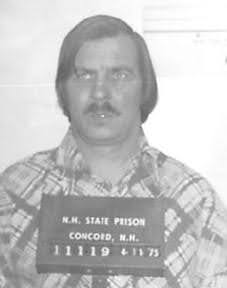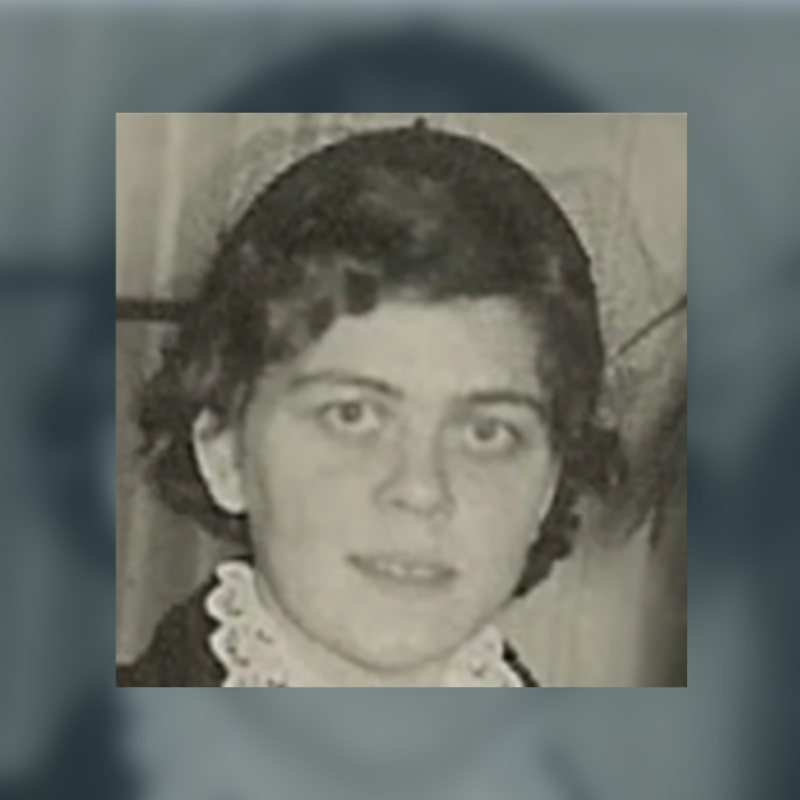For almost three years, the case of Katharina Reitz Brow languished without information or evidence that could bring a true ending to the search for answers. And then when someone was finally arrested, charged, and convicted of her murder, a hard-fought battle by the suspect’s own sister unearthed evidence in a dusty courthouse basement that changed everything about the case nearly two decades later.
Now, just this year, 2025, investigative genetic genealogy has identified the person that investigators believe is actually culpable for Katharina’s death.
May 21, 1980
It was around 10:45 a.m. on the morning of May 21, 1980 and a family member was just arriving at the home of 48-year old Katharina Reitz Brow for a visit. As she stepped up to the front door of 7 1/2 Rosewood Avenue in Ayer, Massachusetts, knocking once and then again, she was met with silence.
With a tentative turn of the door knob, the woman stepped inside to find a terrifying scene. The kitchen was spattered with blood. A TV was chattering away and the kitchen faucet was running, but Katharina wasn’t anywhere she could see. She tried calling out for her, but again was met with nothing. It wasn’t until Ayer Police arrived at the scene that Katharina was finally located; she was deceased in her bedroom. The autopsy found that she was stabbed 30 times. Five of the stab wounds penetrated her heart.
According to reporting by The Evening Gazette, police believed that Katharina had been attacked while she was washing dishes and her assailant was either voluntarily let in – meaning it was someone Katharina may have known and trusted – or they’d entered through an unlocked door, because there were no signs of forced entry. Yet there were signs of a struggle everywhere.
Court records indicate that the attack began in the kitchen and Katharina fought back with a fury. She struggled with the assailant through the house and into the bedroom where she was overtaken. As the Police Chief William Adamson Sr. put it, “It was a very fierce battle.” A demonstration of Katharina’s strength.
The assailant seemed to be looking for something specific and knew where to search for it. The linen closet had been torn apart and Katharina’s purse with cash and jewelry that was normally kept in that closet was missing, along with a stash of cash she kept hidden between sheets in the closet.
Investigators theorized that whoever killed Katharina came to her house that day with a plan, but that plan may not have included committing a brutal and fatal attack. A knife was found discarded in a trash can, covered in blood. The handle bore the name of the company where Katharina’s husband worked. He later confirmed that the knife – the murder weapon – came from their own kitchen.
Katharina also suffered injuries consistent with being struck by a blunt instrument. Several early reports, including a piece published in the Boston Herald, suggest the blunt instrument was a ceramic lamp also found at the scene.
Charles Brow had left the home he shared with Katharina that morning around 7:10 a.m. leaving a three and a half hour-ish window for the murder to occur. The medical examiner hypothesized that it was more likely Katharina died closer to when Charles left for work.
Katharina was a mother of two children who had immigrated to the United States from Germany, and she was saving that money tucked between the sheets of her linen closet for a trip back to visit family. She’d already endured so much. She was home at the time of the murder because she’d suffered a heart attack a few weeks earlier and was still recovering.
Who would target Katharina for such a brutal crime? Who knew about the money?
Suspects
Katharina’s husband Charles worked at R. Murphy Company, which was a knife maker. He does not appear to have been considered a suspect for very long, if at all. Court records state that he was seen around town on the morning of the murder and he may have stopped to have a tire repaired, and then at the post office, before continuing to work. His whereabouts were accounted for.
As interviews with Katharina’s family members and other witnesses continued, a name surfaced that caught the attention of Ayer Police Chief William Adamson and Officer Nancy Taylor. According to court records, Katharina’s family member talked about a man named Kenneth Waters, who lived just behind Katharina’s home and worked at the Park Street Diner, where Katharina was a regular.
According to the family member, people at the diner had seen Katharina carrying large amounts of cash in her wallet, something they told her numerous times wasn’t a good idea. They insisted that Katharina keep the cash at home.
Ayer Police already knew Kenneth’s name. According to Farah Stockman’s reporting for The Boston Globe, he had a quote-unquote “rowdy” reputation in town. He also had a history of violence and criminal charges. According to Patricia W. Montminy’s reporting for The Lowell Sun, just two years earlier in 1978, Kenneth was charged with attempted murder after he slashed a man’s throat in Rockingham County in New Hampshire. The charges were later reduced to aggravated assault and he served somewhere around 18 months of a 3 and a half year sentence in a New Hampshire detention facility.
At the time of Katharina’s murder, Kenneth was working overnights at the diner, but their history dated back even further to Kenneth’s childhood. Kenneth reportedly rode the bus with Katharina’s kids when he was younge and Thomas Grilli reports for The Lowell Sun that Katharina had given him a ride to work just the week before her murder. They may have crossed paths on a semi-regular basis, too, as Kenneth was living with his grandfather at the time, whose home was on Vernon Street adjacent to Rosewood Avenue.
Naturally, police had some questions for Kenneth. Officers caught up with him the next day and transported him to the police station for an interview. Meanwhile, Kenneth’s girlfriend at the time, Brenda Marsh, who also lived at Kenneth’s grandfather’s home with him, told officers that Kenneth had been in court the previous morning on an unrelated charge.
Kenneth told officers that he’d worked a double shift at the diner on the night of May 20th into the 21st, and quickly stopped home to change before leaving for his court date. He had an alibi for the estimated time of the murder; he believed his time cards would prove it, and he saw some of the Ayer officers at the court house, too.
Kenneth was examined for any sign he’d been involved in a struggle. The officer who examined him didn’t note any cuts or scratches and his clothing and shoes were unremarkable as well. No blood, nothing that set off any red flags. But Kenneth’s background and proximity to the scene kept him under a microscope for the investigation.
Continued Investigation
Blood type testing conducted by the Commonwealth of Massachusetts Department of Public Safety determined that the majority of the blood at the scene of Katharina’s murder was Type B, which was consistent with her blood type. However, a small amount of Type O blood was found on towels in the linen closet and near the front door. It was believed that the killer had been injured during the intense struggle, and left behind their blood while rifling through Katharina’s closet in search of money.
There was also hair found at the scene. Much of the hair, including strands found in Katharina’s hands, was found to be microscopically similar to her own hair, but other strands of hair found on the knife were different from Katharina’s hair and believed to have come from her killer.
Investigators also found latent prints throughout the house, namely on a broken piece of a toaster that was damaged in the attack and the kitchen faucet. As investigators attempted to compare these prints to possible suspects, police sought Kenneth Waters for another conversation, this one as part of a voice-stress examination. A voice-stress test is different from a polygraph test; it focuses primarily on discreet changes in someone’s voice that may be present at times of deception. Kenneth passed the test.
In the months after the murder, Kenneth and Brenda moved to Providence, Rhode Island. They eventually broke up and he went to California before entering a treatment program in Arizona for a year.
Meanwhile, the investigation into Katharina’s murder continued, but not with much success. In March of 1981, Ayer Police used hypnosis in hopes of developing leads. The goal wasn’t to generate new information, but to advance what they already had. A relative of Katharina’s and an Ayer Police officer were hypnotized, but what came from that investigative strategy, if anything, isn’t totally clear.
About two and a half years later, the unresolved case saw a major update: Police had identified, and arrested, their primary suspect.
Katharina’s story continues on Dark Downeast. Press play to hear the full episode wherever you get your podcasts.

Katharina Reitz Brow. Source: Middlesex District Attorney’s Office

Katharina Retiz Brow with a family member. Source: Middlesex District Attorney’s Office

Katharina’s home on Rosewood Avenue in Ayer. Source: Middlesex District Attorney’s Office

Suspect Joseph Leo Boudreau identified in 2025 with genetic genealogy. Source: Middlesex District Attorney’s Office

Betty Anne Waters and Kenneth Waters. Source: Innocence Project
Episode Source Material
- Commonwealth vs. Kenneth Waters, Middlesex County, January 5, 1987 – April 23, 1987
- Kenneth Waters: The Innocence Project Case Summary
- Ayer slaying investigated, The Evening Gazette, 22 May 1980
- Ayer housewife, 48, found beaten, stabbed to death, Boston Herald, 22 May 1980
- Police probe murder in Ayer, Worcester Telegram, 23 May 1980
- Murder by Patricia Montminy, The Lowell Sun, 22 Mar 1981
- City man arrested in Mass. slaying, Providence Journal, 13 Oct 1982
- RI man charged in Ayer murder by Patricia W. Montminy, The Lowell Sun, 13 Oct 1982
- Waters once served time, judge told by Patricia W. Montminy, The Lowell Sun, 14 Oct 1982
- Providence man charged in death of Ayer woman, The Evening Gazette, 14 Oct 1982
- Probable cause hearing slated in Ayer murder, Evening Gazette, 21 Oct 1982
- Slaying suspect faces charges in Ayer Nov. 4, The Lowell Sun, 21 Oct 1982
- Murder suspect, The Lowell Sun, 21 Oct 1982
- Probable cause found against suspect in 1980 Ayer murder by Patricia Montminy, The Lowell Sun, 6 Nov 1982
- Waters indicted in Ayer murder, The Lowell Sun, 17 Nov 1982
- Waters’ bail set at $25,000 cash by William Tuttle, The Lowell Sun, 18 Nov 1982
- $250k bail is set for murder suspect in 1980 Ayer death, The Lowell Sun, 19 Nov 1982
- Man pleads innocent to 1980 slaying in Ayer, The Boston Globe, 19 Nov 1982
- Trial set for suspect in Ayer murder, The Lowell Sun, 4 May 1983
- Prosecutor: Suspect bragged about killing by William Tuttle, The Lowell Sun, 5 May 1983
- Slay suspect hawked victim’s jewelry by Andrew Gully, Boston Herald, 6 May 1983
- Two testify Waters admitted to killing by Thomas Grilli, The Lowell Sun, 8 May 1983
- Jury deliberating fate of Ayer man by Thomas Grilli, The Lowell Sun, 11 May 1983
- Man gets lifetime jail term for murder of Ayer woman by Thomas Grilli, The Lowell Sun, 12 May 1983
- Ayer murderer gets life term by Thomas Grilli, The Lowell Sun, 12 May 1983
- R.I. man guilty of Ayer stab-slay by John Birtwell, Boston Herald, 12 May 1983
- Man found guilty of robbery, murder, The Boston Globe, 12 May 1983
- DNA evidence cited in fight to reopen ‘80 Ayer murder case by Jeff Skurck, The Lowell Sun, 12 Aug 2000
- DNA prompts new trial in 1980 slaying, Boston Herald, 14 Mar 2001
- New trial seen in 1980 slaying, AP via The Boston Globe, 14 Mar 2001
- Blood connections by Farah Stockman, The Boston Globe, 15 Mar 2001
- Lawyer’s tenacity gets sibling’s murder conviction overturned, UPI, 15 Mar 2001
- ‘Muddy Waters’ runs free: Convict out after 19 years by Dave Wedge, 16 Mar 2001
- DNA evidence frees inmate who served 18 years by Martin Finucane, The Republican, 16 Mar 2001
- Based on DNA evidence, judge release man who spent nearly 20 years behind bars for Ayer killing by Martin Finucane, North Adams Transcript, 16 Mar 2001
- Investigator still feels freed man is guilty, AP via The Boston Globe, 17 Mar 2001
- The new Brockovich by Farah Stockman, The Boston Globe, 24 Mar 2001
- After 18 years in prison, ‘It’s great to be free’ by Farah Stockman and Mac Daniel, 26 Mar 2001
- Convict’s kin claim DNA test clears him of 1980 murder by Dave Wedge, 15 May 2001
- Con freed by DNA evidence slashed N.H. man’s throat by Dave Wedge, 25 May 2001
- Freed man won’t face 2d trial by Michele Kurtz, The Boston Globe, 27 Jun 2001
- Prosecutors drop plans to retry man freed by DNA evidence, AP via North Adams Transcript, 27 Jun 2001
- Wrongly convicted man injured in fall by Megan Tench, The Boston Globe, 8 Sep 2001
- Freed inmate getting better after big fall by Ken Maguire, The Republican, 11 Sep 2001
- A tragic end to newly won freedom by Farah Stockman and Ellen Barry, The Boston Globe, 20 Sep 2001
- Ayer to pay $3.4m for unjust conviction by Jonathan Saltzman, The Boston Globe, 15 Jul 2009
- Court to consider ‘deterioration’ of man wrongfully convicted in Ayer killing by Lisa Redmond, McClatchy-Tribune Regional News, 19 Jul 2009
- Judge to rule on damages in Kenneth Waters case by Lisa Redmond, Sentinel & Enterprise, 19 Jul 2009
- Ayer to pay $3.1m for wrongful conviction by Johnathan Saltzman, The Boston Globe, 7 Aug 2009
- Law: Forum studies ways to avoid wrongful convictions by Katie Mulvaney, Providence Journal, 30 Jul 2010
- Family disputes Waters’ version of events by Michael McKinney, Providence Journal, 10 Oct 2010
- Failing the Test by Michael Blanding and Lindsay Markel, The Boston Globe, 20 Nov 2011
- PRESS RELEASE: District Attorney announces forensic update in 1980 cold case murder of Katharina Reitz Brow, Middlesex County District Attorney’s Office, 12 Jun 2025
- Former Ogunquit man identified as killer in Massachusetts cold case by Gillian Graham, Portland Press Herald, 13 Jun 2025
- U.S. District Court Case No. 04-10521 Amended Complaint & Jury Demand, Defendant Answers, Judgement
- Joseph Leo Boudreau Obituary, Journal Tribune, February 2004
